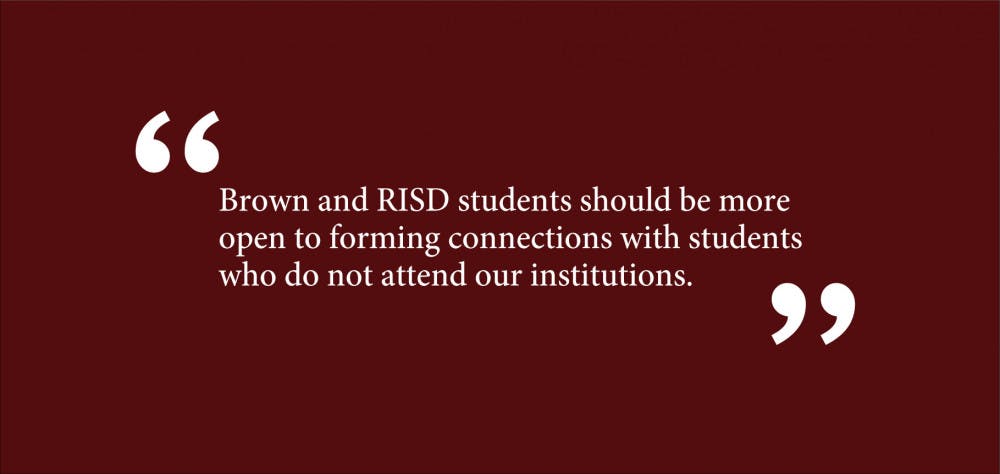As the leaves transform from green to shades of gold and red and the days get noticeably shorter, it’s evident that the seasons are changing. The temperature dropping not only signals the arrival of autumn, but also the arrival of cuffing season. Cuffing season is defined as a period during the fall and winter months when many people find themselves wanting to be in a relationship or “cuffed” with someone. There will be people looking for dating prospects from their classes and their extracurriculars, but plenty of students at Brown will find their matches on dating applications. With dating apps, students have more opportunities to meet people who are more compatible with them, even outside the Brown and Rhode Island School of Design bubble. Unfortunately, students’ usual close-mindedness in looking for partners results in self-segregation and untold missed connections.
Online dating is becoming more and more popular and socially acceptable, especially among young people. Dating apps are mostly infamous for featuring strange people and facilitating hookup culture, but data show that dating apps can create connections between people otherwise separated by race, class, etc. In their paper, “The Strength of Absent Ties: Social Integration via Online Dating,” Josue Ortega and Philipp Hergovich investigated how dating apps have impacted interracial marriage within our society. People are more likely to date within their group of friends and tend to form friendships with others that live near them; people who occupy the same social positions; and people who share the same attitudes and behaviors. Since friendships and social networks are largely structured by race and ethnicity, interracial couples and marriages still aren’t very common — though they are on the rise. To study how dating apps overcome historical barriers, the researchers designed a social network consisting of men and women from different races. Randomly distributed links between individuals were devised to mimic social connections. When the researchers added links between people from different ethnic groups, the number of interracial marriages increased dramatically. The researchers concluded that online dating, with its ability to overcome barriers and make connections, leads to dramatic racial integration.
As dating apps have the potential to create connections, students at Brown should do more to take advantage of these opportunities. Anecdotally, when students use these dating apps, they often swipe left on, or reject, students who do not attend Brown or RISD. Many of them might say that this is because of proximity or safety reasons, which are fair points. On the other hand, Brown and RISD students should be more open to forming connections with students who do not attend our institutions, since it will increase their chances of building a relationship with someone who is compatible with them, despite external differences.
Young adults may also harbor a false sense of security when they meet people online based on proximity alone. Professor of Sociology at the University of Houston Pamela Anne Quiroz discovered in her research that the popularity of dating applications stems from the illusion of “thin trust”— defined as the assumption that if an anonymous person appears similar to you and shares your extended social circle, they are trustworthy. Many individuals on these dating applications believe that this “thin trust” can lead to “thick trust” and ultimately a meaningful relationship.
When Brown students in the Providence area swipe through profiles that say “Brown” or “RISD,” there is a notion of thin trust since they most likely share an extended social circle. This false sense of security can be tricky since it doesn’t necessarily mean a meaningful connection can develop due to surface-level traits. Furthermore, this type of thinking can prevent students from meeting people who attend schools that they aren’t too familiar with, since they do not, at first glance, resemble them.
This mindset that many Brown and RISD students have about dating also stems from a phenomenon called assortative mating, the tendency for individuals to marry people resembling themselves. Educationally assortative mating rose for decades after World War II — when more people began to attend college and more good jobs were reserved for college graduates — and is still in play today. Many Brown students look for romantic partners who, like themselves, are planning on entering a well-paid career, have a family financial situation that resembles theirs and attend a high-status college. It’s worth noting that most elite colleges have certain characteristics that are associated with the students: in the case of Brown, being well-rounded, passionate, intelligent, etc. By swiping right on students at Brown and other elite colleges, they, subconciously or not, associate these characteristics — perhaps exclusively — with these people, too.
It’s important to note that while it’s not bad to want to date someone who resembles you in some ways, educationally assortative mating can be particularly damaging. In the short term, it can limit people to only surrounding themselves with similar perspectives and not being able to grow and be challenged by someone with a different experience. In the long term, educationally assortative mating exacerbates income inequality and social divides. It has been found in studies that through this phenomenon, well-paid college graduates tend to marry each other while poorly paid high school dropouts do the same, which only deepens the gap of income inequality.
While dating apps can give Brown students more chances to meet different people, educationally assortative mating and the false sense of security based on proximity can restrict students in doing this. These biases that are prevalent on campus may be subconsciously affecting these students. If students are looking for a connection of any commitment level, they should consider two things. First, where are they looking for these connections? And secondly, why are they looking for these connections in these places? Thorough reflection on these questions will help address these biases.
Chanel Johnson ’20 can be reached at chanel_johnson@brown.edu. Please send responses to this opinion to letters@browndailyherald.com and op-eds to opinions@browndailyherald.com.





